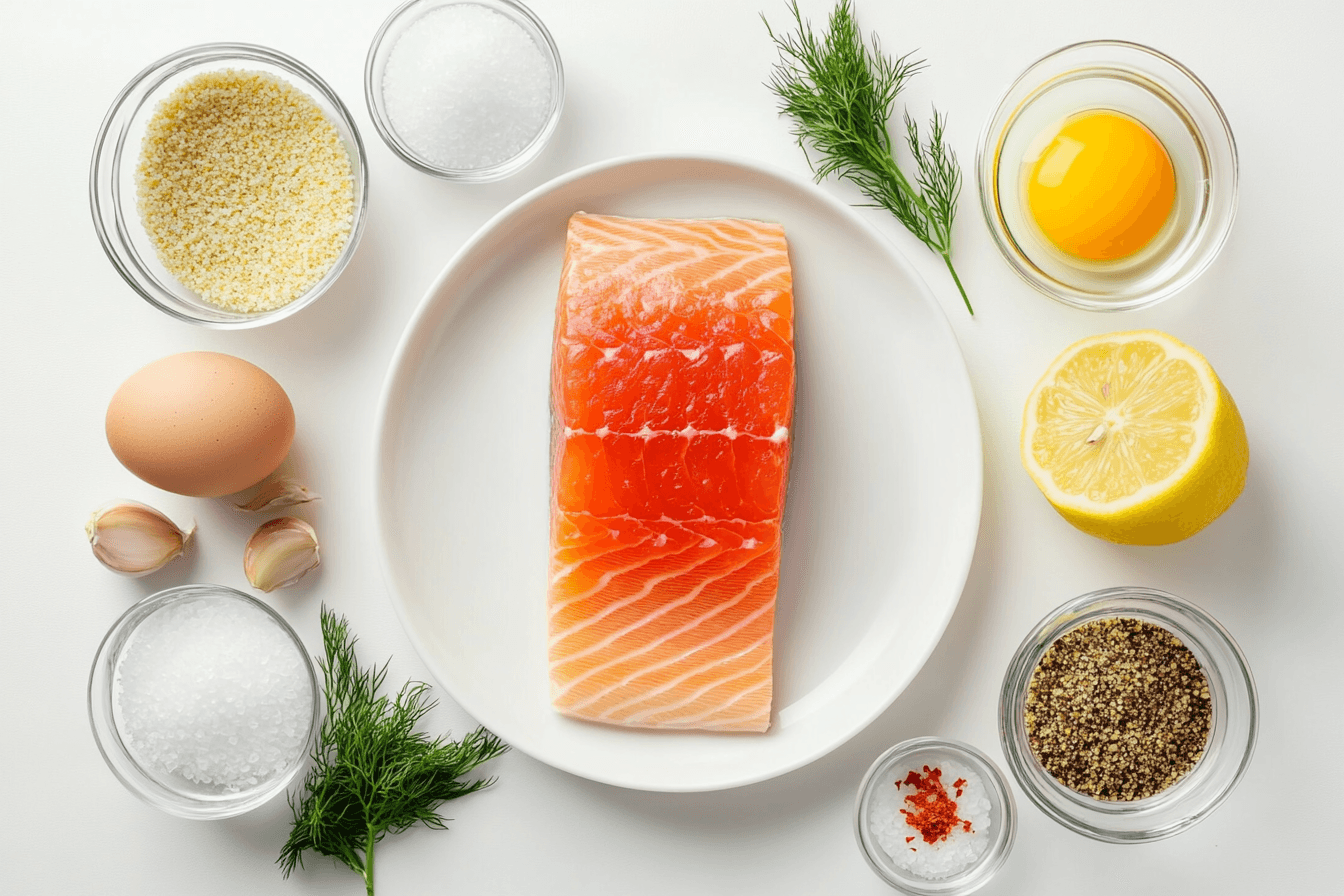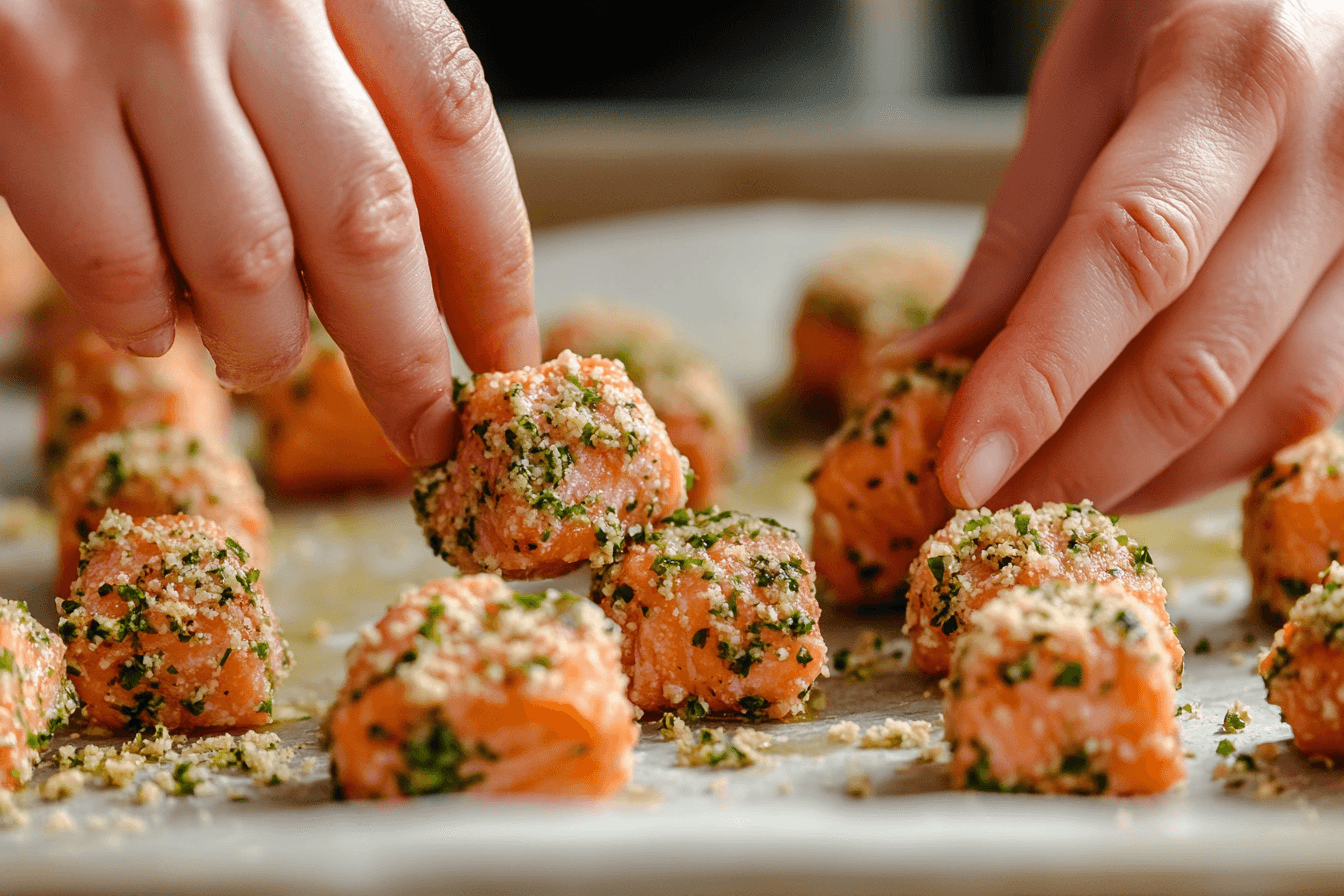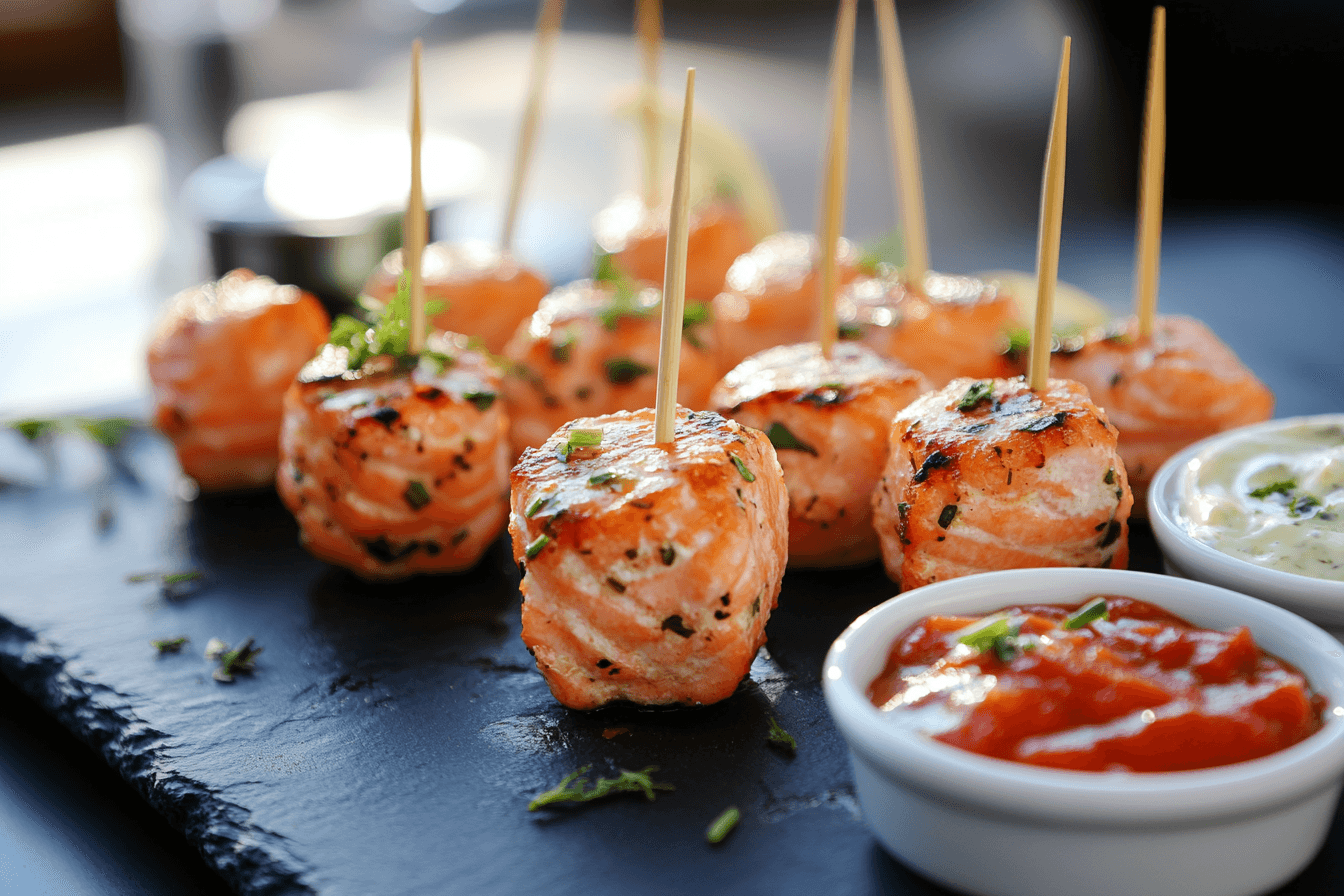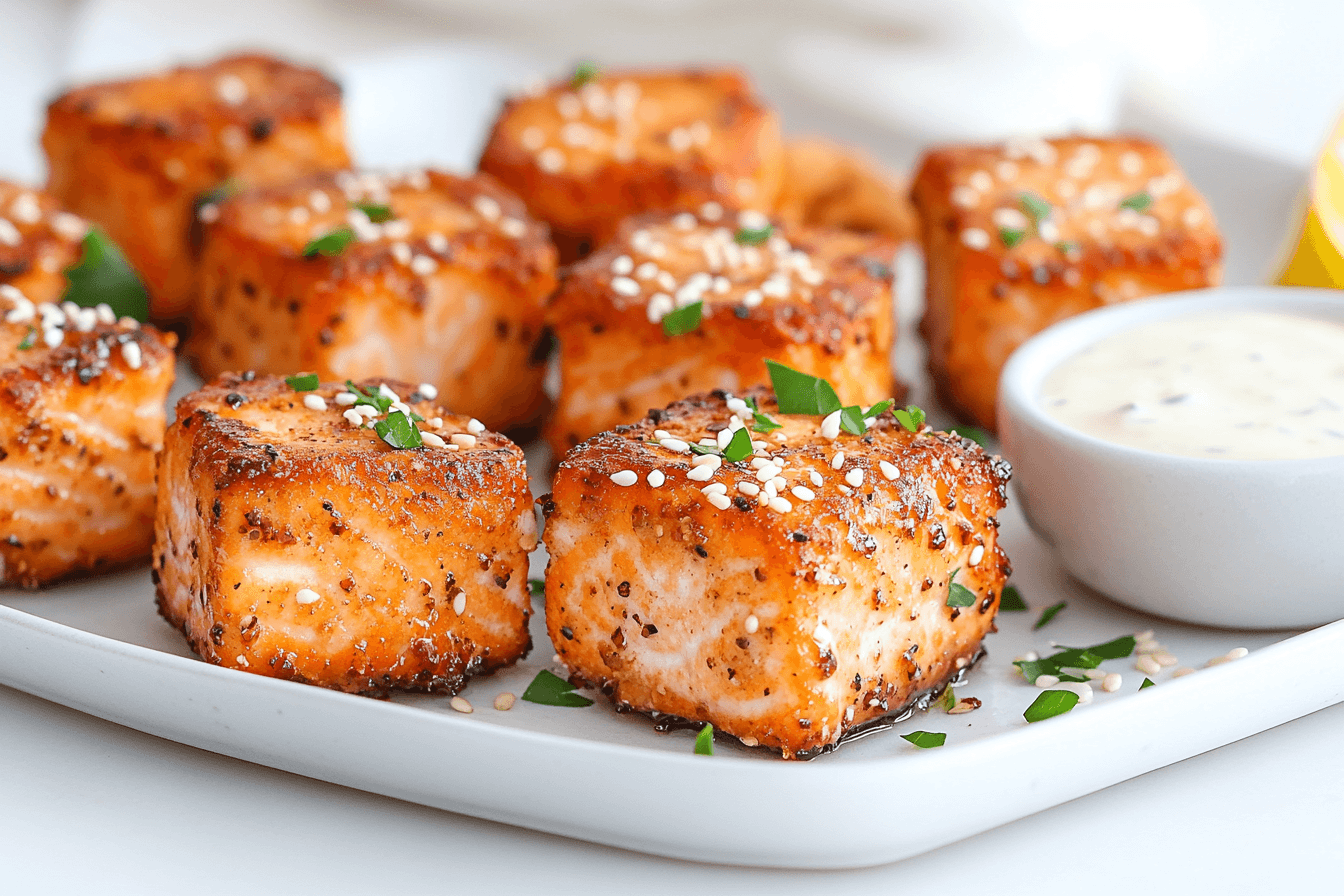In my kitchen, every recipe tells a story. These salmon bites recipes are no exception! My grandmother taught me that the right focus on simple ingredients can transform an ordinary dish into something extraordinary. Today, I’m sharing our family’s favorite salmon bites recipes that bring three generations together – from my grandmother’s traditional wisdom to my daughter’s creative twists.
Why Our Family Loves Salmon Bites Recipes
When my daughter comes home from school asking for a healthy snack, these salmon bites are my go-to solution. The focus on nutritious ingredients makes them perfect for growing kids while satisfying adult taste buds too! Imagine being able to create dishes that are not only delicious but also packed with omega-3 fatty acids and protein.
My grandmother always says quality ingredients come first. She’s right – starting with good salmon makes all the difference in these salmon bites recipes.
Essential Ingredients with a Family Touch
Choosing the Right Salmon
In our family kitchen, we place special attention on selecting the best salmon. Fresh salmon gives you that rich, buttery flavor, but don’t worry if you can only find frozen – it works wonderfully too! My grandmother taught me to look for bright, firm flesh when shopping for salmon bites recipes.
Our Family’s Favorite Seasonings
The magic of our salmon bites recipes comes from a seasoning blend my grandmother perfected over decades:
- Sea salt and freshly ground pepper
- Garlic powder (my addition to modernize the recipes)
- Dried dill (my grandmother’s must-have herb) – the same herb I use in my Perfect Pesto Salmon Recipe
- Lemon zest (my daughter’s favorite addition)

Step-by-Step Guide: Our Family Approach to Salmon Bites Recipes
Preparing the Salmon
- Clean and debone your salmon thoroughly. My grandmother always emphasizes proper preparation – it’s the foundation of any good salmon bites recipes.
- Cut into small, even pieces about an inch in size. My daughter loves helping with this part!
- Pat dry with paper towels to remove excess moisture.
Mixing with Love and Tradition
In our kitchen, mixing ingredients is more than just combining flavors – it’s where we share stories. While my hands work the mixture, I tell my daughter about how my grandmother taught me these salmon bites recipes, keeping our focus on both tradition and creating new memories.

Basic Salmon Bites Recipe:
- 1 pound fresh salmon, finely chopped
- 1 egg (binds everything together)
- ¼ cup breadcrumbs (my modern touch – grandmother used crushed crackers)
- 1 tablespoon fresh lemon juice
- 1 teaspoon each of salt, pepper, and garlic powder
- Fresh herbs (dill and parsley work beautifully)
Mix everything gently with your hands until just combined. My grandmother always says you should handle the salmon mixture with care – overmixing makes tough bites!
Cooking Methods That Connect Generations
My grandmother’s traditional method was pan-frying, but I’ve added modern options to our salmon bites recipes:
Pan-Frying (Grandmother’s Way): Heat olive oil in a skillet over medium heat and cook for 2-3 minutes per side until golden.
Baking (My Modern Approach): Form into bite-sized balls, place on a parchment-lined baking sheet, and bake at 375°F for 15 minutes.
Air Frying (My Daughter’s Favorite): Cook at 375°F for 10 minutes, shaking halfway through.
Three Family-Favorite Salmon Bites Recipes
Spicy Honey Salmon Bites (My Creation)
My focus on bringing modern flavors to traditional salmon bites recipes led to this sweet-spicy variation:
- Add 1 tablespoon each of honey and sriracha to the basic mixture
- Garnish with sliced green onions
- Serve with a cooling yogurt dip
Herbed Lemon Salmon Bites (Grandmother’s Classic)
This is the original among our family salmon bites recipes – simple, elegant, and bursting with fresh flavors:
- Double the fresh herbs (dill and parsley)
- Add extra lemon zest (if you love lemon flavor, you’ll also enjoy my Perfect Pesto Salmon Recipe with its bright citrus notes)
- Mix in 1 teaspoon of dried oregano
- Serve with tzatziki sauce
Crispy Parmesan Salmon Bites (My Daughter’s Invention)
My daughter loves adding cheese to everything, and her contribution to our salmon bites recipes collection is always a hit at family gatherings:
- Mix ¼ cup grated parmesan into the salmon mixture
- Add an extra tablespoon of breadcrumbs for extra crunch
- Sprinkle with more parmesan before cooking
- Serve with marinara dipping sauce
Tips for Perfect Salmon Bites Every Time
My grandmother’s wisdom shines through in these tips that make our salmon bites recipes foolproof:
- Chill Before Cooking: Place formed bites in the refrigerator for 15 minutes to help them hold their shape.
- Don’t Overcook: Salmon should be just cooked through – overcooked salmon bites get dry and tough.
- Sauce Matters: Always serve your salmon bites with a complementary sauce. My daughter says the dipping sauce is half the fun!

Storing and Reheating Your Salmon Bites
When we make these salmon bites recipes, we often double the batch for easy meals later in the week:
- Store in an airtight container in the refrigerator for up to 2 days
- Reheat in a 300°F oven for 10 minutes or air fryer for 3-4 minutes
- For meal prep, freeze uncooked salmon bites and cook from frozen (add 5 minutes to cooking time)
Frequently Asked Questions About Salmon Bites Recipes
Can I use canned salmon for these salmon bites recipes?
Yes! My grandmother sometimes used canned salmon when fresh wasn’t available. Just drain it well, remove any bones, and pat it dry before mixing. You might want to add an extra tablespoon of breadcrumbs since canned salmon tends to be moister.
How do I know when salmon bites are fully cooked?
My grandmother taught me that properly cooked salmon bites should be slightly pink in the center and flake easily with a fork. They typically take 3-4 minutes per side when pan-frying, 15 minutes when baking at 375°F, or 10 minutes in an air fryer.
Can I freeze salmon bites?
Absolutely! In our busy family, we freeze salmon bites all the time. You can freeze them either before or after cooking. For uncooked bites, freeze them on a baking sheet first, then transfer to a freezer bag. Cook from frozen, adding about 5 minutes to the cooking time. For cooked bites, cool completely before freezing and reheat in a 350°F oven for 10-15 minutes.
What’s the best dipping sauce for salmon bites?
My daughter would say there’s no single “best” sauce – it depends on the flavor profile of your salmon bites! For our herbed lemon version, tzatziki is perfect. The spicy honey variation pairs wonderfully with yogurt sauce, and the parmesan bites are delicious with marinara. My grandmother’s classic recommendation is a simple lemon-dill aioli.
Can I make salmon bites ahead for a party?
Yes! This is one of my favorite party prep tricks. Prepare the mixture and form the bites up to 24 hours ahead, keeping them covered in the refrigerator. You can even pan-fry them 2-3 hours before guests arrive and reheat in a 300°F oven for 7-10 minutes just before serving. They’re always a hit at our family gatherings!

Family-Style Salmon Bites
Equipment
- Mixing Bowl
- Knife
- Cutting Board
- Baking Sheet
- Skillet
- Air Fryer
- Parchment Paper
Ingredients
Basic Salmon Bites Mixture
- 1 lb fresh salmon finely chopped
- 1 egg
- 1/4 cup breadcrumbs or crushed crackers
- 1 tbsp fresh lemon juice
- 1 tsp sea salt
- 1 tsp black pepper
- 1 tsp garlic powder
- 1 tbsp fresh dill chopped
- 1 tbsp fresh parsley chopped
Spicy Honey Salmon Bites Variation
- 1 tbsp honey
- 1 tbsp sriracha
- green onions sliced, for garnish
Herbed Lemon Salmon Bites Variation
- 1 tsp dried oregano
- 1 tbsp lemon zest extra, for flavor
Crispy Parmesan Salmon Bites Variation
- 1/4 cup grated parmesan cheese
- 1 tbsp breadcrumbs extra for crunch
- parmesan cheese sprinkle before cooking
Instructions
- Clean and debone the salmon, then cut into 1-inch pieces and pat dry with paper towels
- In a bowl, combine chopped salmon, egg, breadcrumbs, lemon juice, salt, pepper, garlic powder, dill, and parsley
- For Spicy Honey Variation, add honey and sriracha to the basic mixture and garnish with green onions after cooking
- For Herbed Lemon Variation, double the herbs, add lemon zest and dried oregano
- For Parmesan Variation, mix in grated parmesan, extra breadcrumbs, and sprinkle more cheese before cooking
- Gently mix ingredients until just combined—do not overmix
- Form into bite-sized balls or patties and chill in refrigerator for 15 minutes
- To pan-fry, heat olive oil in a skillet over medium heat and cook bites 2-3 minutes per side until golden
- To bake, place on parchment-lined baking sheet and bake at 375°F for 15 minutes
- To air fry, cook at 375°F for 10 minutes, shaking halfway through
Notes
Creating Memories with Salmon Bites Recipes
As I watch my daughter proudly serving her version of our salmon bites recipes to my grandmother, I’m reminded of why I love cooking so much. It’s not just about creating delicious food—it’s about preserving traditions while making space for new ideas and innovations.
These salmon bites recipes have evolved through three generations of our family, each adding their own special touch. My grandmother’s wisdom provides the foundation, my techniques modernize the preparation, and my daughter’s creativity keeps us exploring new flavors.
Whether you’re looking for a quick weeknight dinner, a healthy snack for the kids, or an impressive appetizer for guests, these salmon bites recipes are versatile enough to fit any occasion. The best part? They bring people together around the table, creating those precious moments of connection that make life so special.
I invite you to try these recipes with your own family. Add your personal touches, create your own traditions, and watch as something as simple as salmon bites recipes become a treasured part of your family’s culinary story.
From my family’s kitchen to yours – happy cooking!
